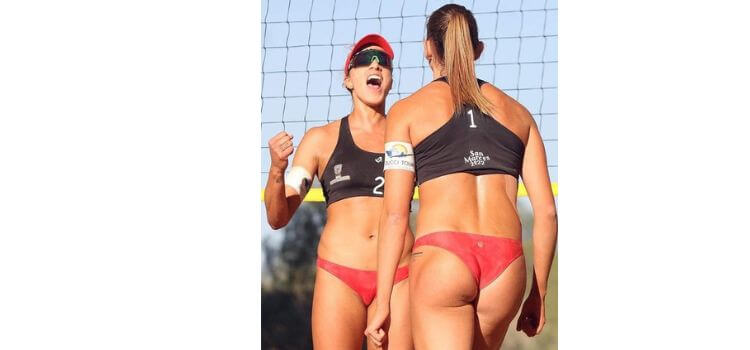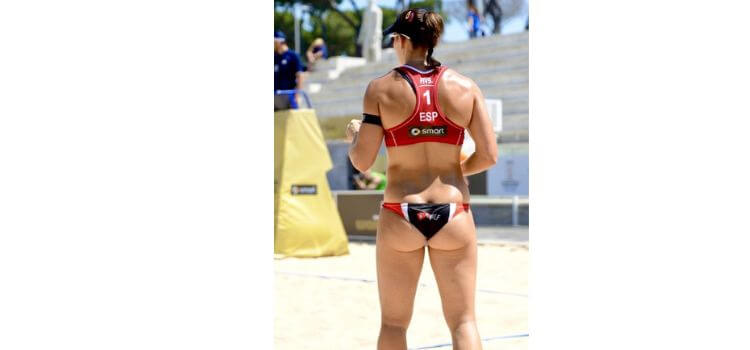As an Amazon Associate, I earn from qualifying purchases
Volleyball is a popular sport that can be enjoyed by people of all ages and skill levels. However, not all volleyball games are the same. Depending on where and how you play, you may encounter different rules, strategies, and challenges.
In this blog post, we will explore What is the difference between beach volleyball and indoor volleyball, two of the most common variations of the sport.
We will compare and contrast their court size and surface, number of players, ball and net, scoring system, and other aspects that make them unique.
By the end of this post, you will have a better understanding of the similarities and differences between beach and indoor volleyball, and hopefully, a greater appreciation for both.
Distinctions Between Beach Volleyball and Indoor Volleyball
Volleyball is among the most popular and widely played sports globally. It is a team sport that involves two teams of players who try to score points by hitting a ball over a net and making it land on the opponent’s side of the court.
Volleyball can be played in various settings and environments, but the two main variations are beach volleyball and indoor volleyball.
Beach volleyball and indoor volleyball are both derived from the same sport, but they have some significant differences that affect the gameplay, strategy, and player experience.
In this article, we will explore the differences and similarities between beach volleyball and indoor volleyball, and how they influence the sport’s popularity and global reach.
History of Volleyball
Volleyball was invented in 1895 by William G. Morgan works as a physical education instructor at the YMCA in Holyoke, Massachusetts. He wanted to create a game that was less physically demanding than basketball, but still required skill and teamwork.
He called his game “mintonette”, and it was originally played with a net, a bladder ball, and a set of rules that were similar to badminton.
The game soon became popular among various groups of people, such as schools, clubs, and military camps. In 1896, the name of the game was changed to “volley ball“, and the first official rules were published.
The game evolved over time, with changes in the ball, the net, the court, and the scoring system. In 1947, the International Volleyball Federation (FIVB) was founded, and the first world championship was held in 1949.
The sport also developed into different forms, such as sitting volleyball, snow volleyball, and grass volleyball.
However, the two most prominent forms are beach volleyball and indoor volleyball, which have their own histories and characteristics.
Basic Gameplay
The basic gameplay of volleyball is similar for both beach and indoor variations. The game is played by two teams of players, who take turns to serve the ball over the net and try to make it land on the opponent’s side of the court.
The teams can touch the ball up to three times before sending it back over the net, but they cannot catch or hold the ball.
The ball must not touch the ground, the net, or any other object outside the court. The team that wins the rally scores a point, and the game continues until one team reaches a certain number of points, usually 25.
Some of the key elements of difference between beach volleyball and indoor volleyball:
Serving: The act of putting the ball into play by hitting it over the net with one hand or arm. The serve can be done from anywhere behind the end line of the court, and it can be either underhand or overhand.
The serve can also be either a float serve, which has little or no spin and moves unpredictably, or a jump serve, which has more power and speed and requires a jump before hitting the ball.
Passing: The act of receiving the ball from the opponent’s serve or attack and sending it to a teammate, usually the setter.
The pass can be done with either the forearms or the hands, depending on the type and height of the ball. The pass is also called a dig if it is done to save a ball that is close to the ground.
Setting: The act of placing the ball in a position where a teammate can attack it. The setter is usually the player who touches the ball second after the pass, and they use their hands to shape the ball and direct it to a specific spot on the court.
The setter can also choose to attack the ball themselves, either by dumping it over the net or by tipping it to an open space.
Spiking: The act of hitting the ball over the net with force and speed, usually from a high position. The spiker is usually the player who touches the ball third after the pass and the set, and they use their arm to swing at the ball and generate power and direction.
The spike can also be either a straight spike, which goes directly over the net, or a cross-court spike, which goes diagonally over the net.
Blocking: The act of preventing the opponent’s attack from crossing the net by placing one or more hands above the net.
The blocker is usually the player who is closest to the net and opposite to the spiker, and they use their hands and arms to form a wall and deflect the ball back to the opponent’s side.
The block can also be either a soft block, which slows down the ball and allows the team to play it, or a hard block, which sends the ball directly to the ground.
Beach Volleyball: The Game on Sand
Beach volleyball is a variation of volleyball that is played on sand, usually on a beach or a specially designed court. It is also known as sand volleyball or outdoor volleyball. Beach volleyball has some unique aspects that make it different from indoor volleyball, such as:
VETRA Premium Soft Touch Volleyball – Official Size
Runleaps Volleyball Ball official size
Mikasa VX20 Beach Classic Volleyball White
Playing on sand: The sand surface affects the movement and stability of the players, as well as the bounce and trajectory of the ball.
The sand can also vary in temperature, texture, and depth, depending on the location and weather conditions.
Playing on sand requires more strength, endurance, and agility than playing on a hard court, as well as different techniques and strategies.
Impact of weather conditions: The weather conditions can also influence the gameplay and outcome of beach volleyball, as they can affect the visibility, wind, humidity, and temperature of the environment.
The weather can also change during the game, requiring the players to adapt and adjust accordingly.
The players have to deal with factors such as sun, rain, wind, heat, and cold, which can affect their performance and comfort.
Strategies specific to beach volleyball: The strategies and tactics used in beach volleyball are different from those used in indoor volleyball, as they have to account for the sand, the weather, and the number of players. Some of the common strategies are:
Using the wind: The wind can be either an advantage or a disadvantage for the players, depending on its direction and strength.
The players can use the wind to their favor by serving or spiking into the wind, which can make the ball drop faster and harder, or by serving or spiking with the wind, which can make the ball fly farther and faster.
The players can also use the wind to their disadvantage by serving or spiking against the wind, which can make the ball float or drift, or by serving or spiking crosswind, which can make the ball curve or swerve.
Using the sun: The sun can also be either an advantage or a disadvantage for the players, depending on its position and angle. The players can use the sun to their favor by serving or spiking into the sun, which can blind or distract the opponent, or by serving or spiking away from the sun, which can make the ball more visible and easier to handle. The players can also use the sun to their disadvantage by serving or spiking against the sun, which can make the ball harder to see or judge, or by serving or spiking cross-sun, which can create shadows or glare.
Using the sand: The sand can also be used as a weapon or a shield by the players, depending on the situation.
The players can use the sand to their advantage by digging or diving into the sand, which can cushion the impact and allow them to save or recover the ball, or by throwing or kicking the sand, which can annoy or distract the opponent.
The players can also use the sand to their disadvantage by slipping or sinking into the sand, which can reduce their speed and balance, or by getting sand in their eyes, mouth, or ears, which can impair their vision, breathing, or hearing.
Some of the specific aspects of beach volleyball are:
1. Court Size and Dimensions
The court size and dimensions of beach volleyball are different from those of indoor volleyball. The beach volleyball court is smaller and narrower, measuring 16 by 8 meters (52.5 by 26.2 feet), compared to the indoor volleyball court, which measures 18 by 9 meters (59 by 29.5 feet).
The net height is also lower in beach volleyball, measuring 2.43 meters (7 feet 11 5/8 inches) for men and 2.24 meters (7 feet 4 1/8 inches) for women, compared to the indoor volleyball net, which measures 2.43 meters (7 feet 11 5/8 inches) for both men and women.
The smaller and lower court and net in beach volleyball have an impact on the gameplay and strategy, as they create more space and angles for the players to attack and defend.
The players have to cover more ground and react faster, as well as use more finesse and precision, than in indoor volleyball.
2. Number of Players
The number of players per team in beach volleyball is also different from that of indoor volleyball. Beach volleyball is played by two players per team, who have to play all positions and roles, compared to indoor volleyball, which is played by six players per team, who have specific positions and roles.
The two players in beach volleyball are usually called the left-side player and the right-side player, depending on their position on the court, and they can switch sides after each point.
Major Difference: Number of Players
Indoor Volleyball:
6 players per team: Specialized roles like setter, hitter, middle blocker, libero.
Impact: Structured teamwork, pre-planned plays, strategic formations.
Example: A setter focuses on sending perfect passes to designated hitters.
Beach Volleyball:
2 players per team: Versatile individuals performing all skills.
Impact: Adaptability, improvisation, strong communication required.
Example: Both players need to be proficient in digging, setting, and spiking.
This single difference in player count influences many aspects of the game:
Gameplay pace: Indoor is faster with more players covering the court.
Strategy: Indoor emphasizes pre-determined plays, while beach focuses on on-the-fly adjustments.
Skill focus: Indoor players specialize, while beach players need well-rounded skillsets.
Individual freedom: Indoor players follow designated roles, while beach players have more creative freedom.
Sure, I will continue writing the article based on your keyword and outline. Here is the next part of the draft:
3. Ball Type
The type of ball used in beach volleyball is also different from that of indoor volleyball. The beach volleyball ball is larger and lighter, measuring 66 to 68 centimeters (26 to 27 inches) in circumference and weighing 260 to 280 grams (9 to 10 ounces), compared to the indoor volleyball ball, which measures 65 to 67 centimeters (25.5 to 26.5 inches) in circumference and weighs 260 to 280 grams (9 to 10 ounces).
The beach volleyball ball is also softer and smoother, with fewer panels and stitches, than the indoor volleyball ball, which is harder and rougher, with more panels and stitches.
The different ball type in beach volleyball affects the handling and gameplay, as it makes the ball more susceptible to the wind and the sand.
The ball can also lose air pressure or become wet due to the weather conditions. The players have to adjust their touch and technique, as well as their timing and placement, to control the ball better and avoid errors.
The ball also requires more power and speed to hit and pass, as it has less bounce and spin than the indoor volleyball ball.
4. Attire and Equipment
The attire and equipment used in beach volleyball are also different from those used in indoor volleyball. The beach volleyball attire is more casual and minimal, consisting of shorts, bikinis, tank tops, or singlets, depending on the gender and preference of the players.
The beach volleyball equipment is also simpler and cheaper, requiring only a net, a ball, and some poles or anchors to set up the court.
The players usually play barefoot or with socks or sandals, and they may use sunglasses, hats, or sunscreen to protect themselves from the sun.
The different attire and equipment in beach volleyball have practical considerations for playing on sand. The attire is designed to provide comfort, flexibility, and breathability, as well as to reduce the amount of sand that sticks to the body.
The equipment is designed to be easy to transport, assemble, and disassemble, as well as to withstand the outdoor conditions. The players also have to consider the safety and hygiene of playing on sand, and avoid injuries or infections caused by the sand or the sun.
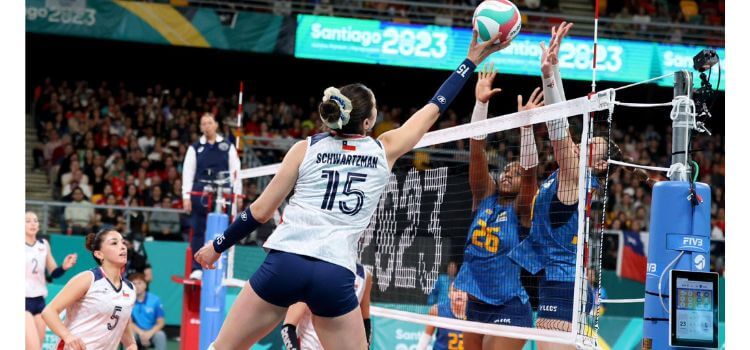
5. Scoring System
The scoring system in beach volleyball is also different from that of indoor volleyball. Beach volleyball uses a rally point system, which means that a point is scored on every rally, regardless of which team serves.
The game is played in sets, usually best of three, and each set is played to 21 points, with a two-point advantage required to win. The exception is the final set, which is played to 15 points, with a two-point advantage required to win.
Indoor volleyball also uses a rally point system, but the game is played in sets, usually best of five, and each set is played to 25 points, with a two-point advantage required to win.
The exception is the final set, which is played to 15 points, with a two-point advantage required to win.
The different scoring system in beach volleyball affects the pace and intensity of the game, as it makes every rally count and every point crucial.
The game is also shorter and faster, as it requires fewer points and sets to win. The players have to be more focused and consistent, as well as more aggressive and strategic, to gain and maintain the lead.
The game also has more suspense and excitement, as it can have more twists and turns, and more comebacks and upsets.
Indoor Volleyball: The Game in the Gym
Indoor volleyball is the original and most common variation of volleyball that is played on a hard court indoors. It is also known as court volleyball or indoor hard court volleyball. Indoor volleyball has some characteristics that make it different from beach volleyball, such as:
WILSON Outdoor Recreational Volleyball – Official Size
Tachikara Institutional Quality Composite Leather Volleyball
Molten Recreational Volleyball
Playing on a hard court: The hard court surface affects the movement and stability of the players, as well as the bounce and trajectory of the ball.
The hard court can also vary in material, color, and markings, depending on the venue and the level of competition. Playing on a hard court requires more skill, technique, and strategy than playing on sand, as well as different equipment and rules.
No impact of weather conditions: The weather conditions have no influence on the gameplay and outcome of indoor volleyball, as the game is played in a controlled and consistent environment.
The weather can only affect the external factors, such as the attendance, the atmosphere, and the transportation of the players and the spectators.
The players do not have to deal with factors such as sun, rain, wind, heat, and cold, which can affect their performance and comfort in beach volleyball.
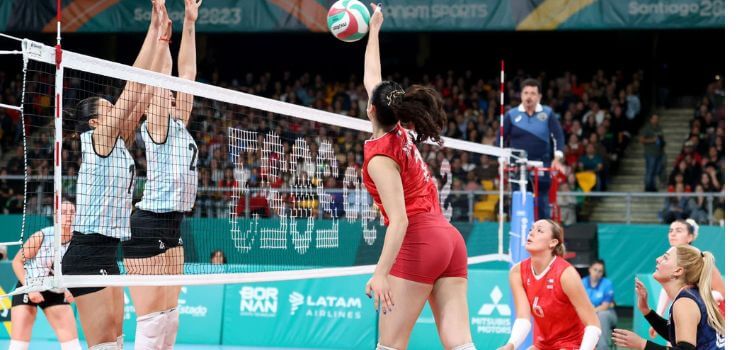
Strategies specific to indoor volleyball: The strategies and tactics used in indoor volleyball are different from those used in beach volleyball, as they have to account for the hard court, the number of players, and the rules. Some of the common strategies are:
Using the rotation: The rotation is the order and position of the players on the court, which changes after each point scored by the serving team.
The rotation affects the roles and responsibilities of the players, as well as their alignment and formation on the court. The players have to follow the rotation rules, which state that the players must be in their correct position before the serve, and that the players must rotate clockwise when they win the serve.
The players can also use the rotation to their advantage by creating mismatches or exploiting weaknesses in the opponent’s defense or offense.
Using the substitution: The substitution is the act of replacing one player with another player during the game, usually to change the strategy or to rest a player.
The substitution rules vary depending on the level and type of competition, but they generally limit the number and frequency of substitutions, and require the approval of the referee.
The players can use the substitution to their favor by bringing in fresh or specialized players, such as defensive or offensive specialists, or by changing the pace or style of the game.
Using the timeout: The timeout is the act of requesting a pause in the game, usually to communicate with the coach or the teammates, or to disrupt the momentum of the opponent.
The timeout rules also vary depending on the level and type of competition, but they generally limit the number and duration of timeouts, and require the signal of the captain or the coach.
The players can use the timeout to their advantage by regaining their focus or confidence, or by adjusting their strategy or tactics.
Some of the specific aspects of indoor volleyball are:
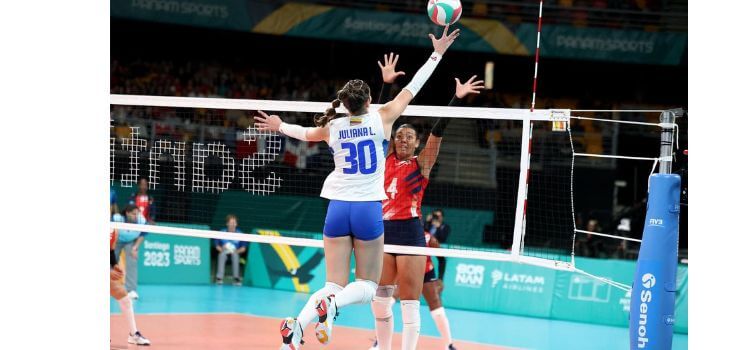
1.Court Size and Dimensions: Diving Deep into the Differences
Indoor Volleyball:
Size: 9 meters wide x 18 meters long (29.5ft x 59ft)
Net Height: 2.43 meters for men, 2.24 meters for women (7.97ft and 7.35ft)
Impact on Gameplay:
Faster Paced: The larger court allows players to cover more ground, leading to quicker transitions between hits and digs.
Strategic Formations: Teams can utilize specialized positions like setter, spiker, and blocker, creating strategic formations for attacks and defense.
Predictable Ball Trajectory: The enclosed environment minimizes wind and sand interference, resulting in more predictable ball paths and easier anticipation.
Emphasis on Power: The harder court surface and heavier ball encourage powerful spikes and serves, demanding strength and precision.
Beach Volleyball:
Size: 8 meters wide x 16 meters long (26.2ft x 52.5ft)
Net Height: Same as indoor volleyball (2.43m for men, 2.24m for women)
Impact on Gameplay:
Agility and Communication Key: With less space, players need to react quickly and communicate effectively to cover the entire court.
Adaptability: The wind and sand introduce an element of unpredictability, demanding quick adjustments and improvisation.
Individual Skill Mastery: Each player needs to be well-rounded in all volleyball skills, from digging to spiking.
Focus on Control: The softer ball and sand require softer touches and controlled plays compared to the power-focused indoor game.
Key Differences:
Area: Indoor court is 54% larger, providing more room for maneuver and strategic plays.
Playing Surface: Indoor offers predictable bounces, while sand introduces an element of randomness.
Ball: Indoor ball is heavier for powerful hits, while the beach ball is softer for control and digging.
Remember: These differences significantly impact the overall gameplay experience. Indoor emphasizes speed, power, and teamwork, while beach focuses on agility, adaptability, and individual skill mastery. Choosing between them depends on your preferred playing style and desired challenges.
2. Number of Players:
Unveiling the Teamwork vs. Versatility Divide
Indoor Volleyball:
Standard: 6 players per team, each with designated positions like setter, hitter, libero, and middle blocker.
Dynamics:
Structured Teamwork: Players focus on mastering specific skills for their positions, leading to well-rehearsed plays and complex strategies.
Substitution Potential: Teams can adapt their lineup throughout the game depending on the situation and opponent’s weaknesses.
Specialization: Each player contributes a unique skill set, maximizing team efficiency and offensive power.
Limited Individual Freedom: Play revolves around designated roles, leaving less room for individual improvisation.
Beach Volleyball:
Standard: 2 players per team, requiring them to master all volleyball skills.
Dynamics:
Adaptability and Improvisation: Plays develop organically based on the situation, demanding quick reactions and adjustments.
Strong Communication: Constant communication is crucial as both players need to cover all areas of the court.
Individual Prowess: Success heavily relies on each player’s athleticism, skill set, and decision-making ability.
More Freedom and Creativity: Players have greater freedom to express their individual style and take on diverse roles within plays.
Key Differences:
Number of Players: Indoor teams have 3 times more players, allowing for specialization and structured plays.
Roles and Responsibilities: Indoor players have assigned positions, while beach players need to be versatile and perform all skills.
Play Development: Indoor plays are often pre-planned, while beach plays evolve organically based on the situation.
Focus: Indoor emphasizes teamwork and strategy, while beach emphasizes individual skill and adaptability.
Remember: The contrasting team sizes significantly impact the gameplay experience. Indoor fosters a team-oriented approach with pre-defined roles, while beach encourages individual brilliance and on-the-fly adjustments. Choosing between them depends on your preference for structured teamwork or individual freedom and adaptation.
3. Ball Type: Unveiling the Power vs. Control Divide
Indoor Volleyball Ball:
Description:
Material: Leather or synthetic leather for durability and consistent performance.
Weight: Heavier (260-280 grams) for powerful hits and serves.
Size: Smaller (65-67 cm circumference) for quicker control and manipulation.
Panel Design: 18 panels stitched together for a smooth and predictable bounce.
Handling:
Emphasis on Power: Designed for strong hits and serves, requiring precise technique and strength to control the ball’s speed and direction.
Faster Reaction Time: Smaller size demands quicker reflexes and hand-eye coordination for effective passing and digging.
Limited Bounce: Hard court surface minimizes bounce height, encouraging quicker attacks and transitions.
Beach Volleyball Ball:
Description:
Material: Composite materials for water resistance and durability.
Weight: Lighter (260-280 grams) for better control and softer touches.
Size: Slightly larger (66-68 cm circumference) for increased air volume and slower flight.
Panel Design: 18 panels stitched or molded for consistent performance.
Handling:
Focus on Control: Softer texture demands softer touches and greater finesse for setting, digging, and bump passes.
Adaptability to Sand: Larger size and slower flight allow for controlled plays amidst the unpredictable bounces on sand.
Higher Bounces: Sand absorbs some impact, resulting in higher bounces that require adjusting digs and setting height.
Key Differences:
Weight: Indoor ball is heavier for powerful hits, while the beach ball is lighter for better control.
Size: Indoor ball is slightly smaller for faster manipulation, while the beach ball is slightly larger for slower flight and higher bounces.
Material: Indoor ball prioritizes durability, while the beach ball emphasizes water resistance.
Handling: Indoor focuses on power and precision, while beach prioritizes control and adaptation to sand.
Remember: The ball type significantly impacts the overall gameplay experience. Indoor encourages powerful attacks and quick reactions, while beach emphasizes softer touches and adapting to the sand’s influence. Choosing between them depends on your preferred style: fast-paced power plays or controlled, sand-adapted techniques.
4. Attire and Equipment: Unveiling the Comfort vs. Performance Divide
Indoor Volleyball:
Typical Attire:
Lightweight uniforms made of breathable fabric for comfort and movement.
Knee pads for protection against falls and dives.
Court shoes with good traction for quick maneuvers on the hard surface.
Additional Equipment: Volleyball itself. Ankle braces for support. Sweatbands for moisture absorption.
Focus on Performance: Indoor attire prioritizes quick movement, sweat management, and protection for dives on a hard court.
Footwear: Indoor shoes offer maximum grip for fast changes of direction on the smooth surface.
Less Emphasis on Comfort: Indoor uniforms are designed for functionality and performance, sacrificing some comfort compared to beach wear.
Beach Volleyball:
Focus on Comfort and Adaptability: Beach attire prioritizes movement in sand, sun protection, and personal preference.
Footwear: Beach shoes provide grip and ankle support for digging and jumping in sand.
More Emphasis on Comfort: Beach wear prioritizes comfort and breathability for extended time spent in the sun and sand.
Remember: The contrasting attire and equipment reflect the different playing environments. Indoor prioritizes performance and protection for a fast-paced game on a hard court, while beach focuses on comfort and adapting to the unique challenges of sand.
Choosing between them depends on your preference for comfort in a natural environment or performance optimization on a hard court.
5. Scoring System: Understanding the Set and Match Format
Indoor Volleyball:
Sets: Games are played to the best of 5 sets.
Set Scoring: Each set is played to 25 points, with a win by 2 points (e.g., 25-23, 26-24).
Timeouts: Each team is allowed 2 timeouts per set.
Substitutions: Unlimited substitutions are allowed during timeouts and between sets.
Contrasts with Beach Volleyball:
Sets: Games are played to the best of 3 sets.
Set Scoring: Each set is played to 21 points, with a win by 2 points (e.g., 21-19, 22-20).
No Timeouts: Timeouts are not allowed in beach volleyball.
No Substitutions: Substitutions are not allowed throughout the game.
Remember: The different scoring systems impact game duration, intensity, and strategic decisions. Indoor games can be longer and more strategic with timeouts and substitutions, while beach games are usually quicker and require immediate adaptation due to the lack of pauses and limited player options.
Choosing between them depends on your preference for longer, strategic matches or faster, more dynamic competitions.
Key Differences Between Beach and Indoor Volleyball
Both beach and indoor volleyball share the core idea of bumping, setting, and spiking a ball over a net, but the differences between them are vast and create distinctly different gameplay experiences. Here are some key distinctions:
Playing Surface:
Beach volleyball: Played on fine, loose sand, demanding agility and explosiveness due to reduced traction.
Indoor volleyball: Played on a smooth, hard surface (usually wood) allowing for faster movements and precise footwork.
Number of Players:
Beach volleyball: Teams consist of only two players, requiring versatility and adaptability.
Indoor volleyball: Teams have six players with specialized positions, promoting strategic rotations and teamwork.
Ball:
Beach volleyball: Slightly larger and lighter, designed for better visibility and control in outdoor conditions.
Indoor volleyball: Heavier and made of leather, promoting faster gameplay and powerful attacks.
Scoring:
Beach volleyball: Best-of-three sets, first to 21 points (except the third set, which is to 15).
Indoor volleyball: Best-of-five sets, first to 25 points (except the fifth set, which is to 15).
Serving:
Beach volleyball: More diverse serving styles, including underhand and float serves, due to sand difficulty with jump serves.
Indoor volleyball: Primarily overhand jump serves for power and strategic placement.
Gameplay:
Beach volleyball: More individualistic, emphasizing improvisation, athleticism, and adapting to wind and sun.
Indoor volleyball: More structured, involving complex rotations, specialized skills, and strategic plays.
Overall:
Beach volleyball: Known for its fast-paced rallies, athleticism, and individual brilliance.
Indoor volleyball: Emphasizes teamwork, strategy, and powerful attacks.
It’s important to note that both variations offer unique challenges and rewards, attracting different skills and preferences. Which one you prefer depends on your personal style and desired experience!
Conclusion:
Beach and indoor volleyball offer distinct experiences despite their core similarities. Understanding these differences empowers you to choose the variation that best suits your playing style and preferences.
Both variations demand athleticism, skill, and dedication, fostering camaraderie and competition in unique ways.
Whether you crave the fast-paced thrill of beach or the strategic depth of indoor, both variations present rewarding challenges and opportunities for personal growth.
FAQ
FAQ: Beach Volleyball vs. Indoor Volleyball
Q: What’s the main difference between beach volleyball and indoor volleyball?
A: The most striking difference is the number of players:
Indoor: 6 players per team with specialized positions.
Beach: 2 players per team, requiring individual mastery of all skills.
This impacts other aspects like:
Court Size: Indoor courts are larger, allowing for strategic formations and faster gameplay. Beach courts are smaller, demanding agility and communication.
Ball: Indoor ball is heavier for powerful hits, while the beach ball is lighter for better control in sand.
Attire and Equipment: Indoor gear prioritizes performance and protection, while beach gear emphasizes comfort and sand adaptation.
Scoring: Indoor sets are longer (25 points), while beach sets are shorter (21 points).
Gameplay: Indoor emphasizes teamwork and strategy, while beach focuses on individual skill and adaptability.
Q: Which is harder: beach or indoor volleyball?
A: Difficulty is subjective and depends on individual strengths and preferences.
Indoor: Mastering specific skills and executing pre-planned plays can be challenging.
Beach: Adapting to sand, mastering diverse skills, and communicating effectively under pressure can be demanding.
Both require athleticism, dedication, and strategic thinking.
Q: Which is more popular: beach or indoor volleyball?
A: Indoor volleyball has wider global participation, especially in Asia and Europe. Beach volleyball is growing in popularity, particularly in coastal regions and North America. Popularity varies regionally.
Q: What skills are similar in both variations?
A: Both require fundamental skills like passing, setting, hitting, digging, and blocking. Reading the ball, communication, and technical mastery are crucial in both variations.
Q: Which variation should I try?
A: Choose based on your preferences:
Indoor: Enjoy structured teamwork and strategic plays? Try indoor.
Beach: Prefer individual freedom, adaptability, and playing in sand? Beach might be your choice.
Ultimately, both offer rewarding experiences and opportunities to have fun and develop volleyball skills.

